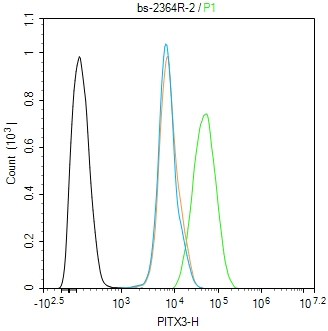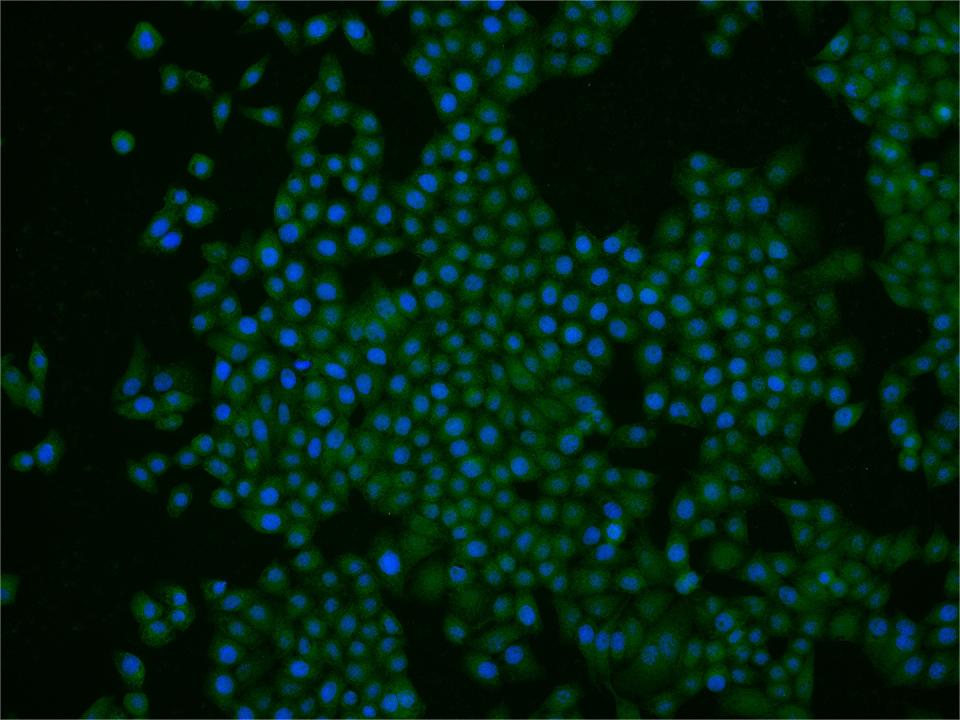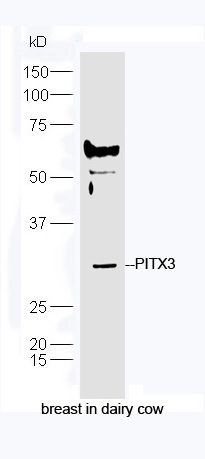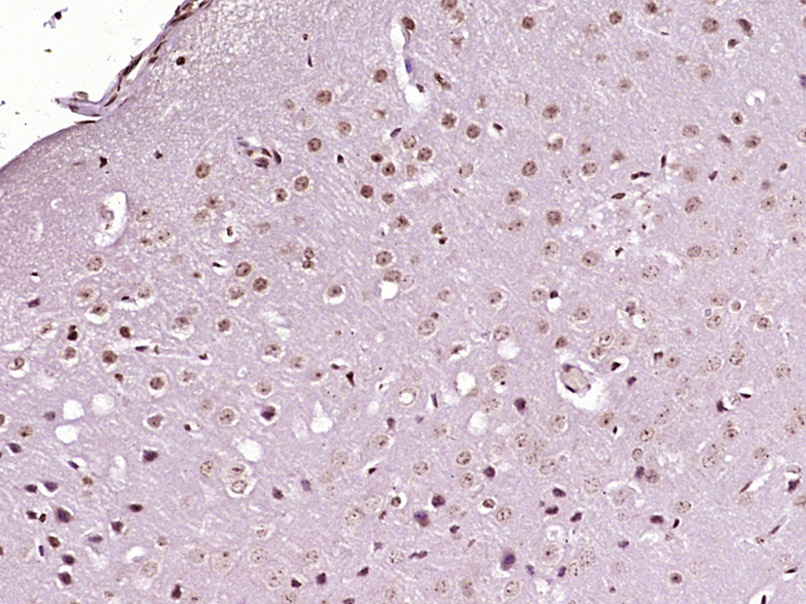PITX3 Rabbit pAb
PITX3 Rabbit pAb
- 产品详情
- 实验流程
- 背景知识
Application
| WB, IHC-P, IHC-F, IF |
|---|---|
| Primary Accession | O75364 |
| Reactivity | Human, Mouse, Rat |
| Predicted | Chicken, Dog, Pig, Horse, Rabbit |
| Host | Rabbit |
| Clonality | Polyclonal |
| Calculated MW | 31832 Da |
| Physical State | Liquid |
| Immunogen | KLH conjugated synthetic peptide derived from human PITX3 |
| Epitope Specificity | 231-302/302 |
| Isotype | IgG |
| Purity | affinity purified by Protein A |
| Buffer | 0.01M TBS (pH7.4) with 1% BSA, 0.02% Proclin300 and 50% Glycerol. |
| SUBCELLULAR LOCATION | Nucleus. |
| SIMILARITY | Belongs to the paired homeobox family. Bicoid subfamily.Contains 1 homeobox DNA-binding domain. |
| SUBUNIT | Interacts with SFPQ. |
| DISEASE | Defects in PITX3 are a cause of cataract autosomal dominant (ADC) [MIM:604219]. Cataract is an opacification of the crystalline lens of the eye that frequently results in visual impairment or blindness. Opacities vary in morphology, are often confined to a portion of the lens, and may be static or progressive. In general, the more posteriorly located and dense an opacity, the greater the impact on visual function. Cataract is the most common treatable cause of visual disability in childhood.Defects in PITX3 are a cause of anterior segment mesenchymal dysgenesis (ASMD) [MIM:107250]; also known as anterior segment ocular dysgenesis (ASOD). ASMD consists of a range of developmental defects in structures at the front of the eye, resulting from abnormal migration or differentiation of the neural crest derived mesenchymal cells that give rise to the cornea, iris, and other components of the anterior chamber during eye development. Mature anterior segment anomalies are associated with an increased risk of glaucoma and corneal opacity. Conditions falling within the phenotypic spectrum include aniridia, posterior embryotoxon, Axenfeld anomaly, Reiger anomaly/syndrome, Peters anomaly, and iridogoniodysgenesis. Defects in PITX3 are the cause of cataract posterior polar type 4 (CTPP4) [MIM:610623]. A subcapsular opacity, usually disk-shaped, located at the back of the lens. It can have a marked effect on visual acuity. Some patients affected by cataract posterior polar type 4 can present a severe phenotype including microphthalmia and neurological dysfunction. |
| Important Note | This product as supplied is intended for research use only, not for use in human, therapeutic or diagnostic applications. |
| Background Descriptions | The transcription factor PITX3 is expressed selectively in the midbrain and regulates the differentiation and survival of dopaminergic neurons. Lack of this factor results in a degeneration similar to that seen in Parkinson's disease. PITX3 is also important in eye developement; mutations of the PITX3 gene have been associated with a familial form of cataracts. |
| Gene ID | 5309 |
|---|---|
| Other Names | Pituitary homeobox 3, Homeobox protein PITX3, Paired-like homeodomain transcription factor 3, PITX3, PTX3 |
| Target/Specificity | Highly expressed in developing eye lens. |
| Dilution | WB=1:500-2000,IHC-P=1:100-500,IHC-F=1:100-500,ICC/IF=1:100-500,IF=1:100-500,Flow-Cyt=2ug/Test |
| Storage | Store at -20 °C for one year. Avoid repeated freeze/thaw cycles. When reconstituted in sterile pH 7.4 0.01M PBS or diluent of antibody the antibody is stable for at least two weeks at 2-4 °C. |
| Name | PITX3 |
|---|---|
| Synonyms | PTX3 |
| Function | Transcriptional regulator which is important for the differentiation and maintenance of meso-diencephalic dopaminergic (mdDA) neurons during development. In addition to its importance during development, it also has roles in the long-term survival and maintenance of the mdDA neurons. Activates NR4A2/NURR1-mediated transcription of genes such as SLC6A3, SLC18A2, TH and DRD2 which are essential for development of mdDA neurons. Acts by decreasing the interaction of NR4A2/NURR1 with the corepressor NCOR2/SMRT which acts through histone deacetylases (HDACs) to keep promoters of NR4A2/NURR1 target genes in a repressed deacetylated state. Essential for the normal lens development and differentiation. Plays a critical role in the maintenance of mitotic activity of lens epithelial cells, fiber cell differentiation and in the control of the temporal and spatial activation of fiber cell-specific crystallins. Positively regulates FOXE3 expression and negatively regulates PROX1 in the anterior lens epithelium, preventing activation of CDKN1B/P27Kip1 and CDKN1C/P57Kip2 and thus maintains lens epithelial cells in cell cycle (By similarity). |
| Cellular Location | Nucleus {ECO:0000255|PROSITE-ProRule:PRU00108, ECO:0000255|PROSITE-ProRule:PRU00138} |
| Tissue Location | Highly expressed in developing eye lens. |
Research Areas
For Research Use Only. Not For Use In Diagnostic Procedures.
Application Protocols
Provided below are standard protocols that you may find useful for product applications.
BACKGROUND
The transcription factor PITX3 is expressed selectively in the midbrain and regulates the differentiation and survival of dopaminergic neurons. Lack of this factor results in a degeneration similar to that seen in Parkinson's disease. PITX3 is also important in eye developement; mutations of the PITX3 gene have been associated with a familial form of cataracts.
终于等到您。ABCEPTA(百远生物)抗体产品。
点击下方“我要评价 ”按钮提交您的反馈信息,您的反馈和评价是我们最宝贵的财富之一,
我们将在1-3个工作日内处理您的反馈信息。
如有疑问,联系:0512-88856768 tech-china@abcepta.com.
¥ 1,500.00
Cat# AP58004























 癌症的基本特征包括细胞增殖、血管生成、迁移、凋亡逃避机制和细胞永生等。找到癌症发生过程中这些通路的关键标记物和对应的抗体用于检测至关重要。
癌症的基本特征包括细胞增殖、血管生成、迁移、凋亡逃避机制和细胞永生等。找到癌症发生过程中这些通路的关键标记物和对应的抗体用于检测至关重要。 为您推荐一个泛素化位点预测神器——泛素化分析工具,可以为您的蛋白的泛素化位点作出预测和评分。
为您推荐一个泛素化位点预测神器——泛素化分析工具,可以为您的蛋白的泛素化位点作出预测和评分。 细胞自噬受体图形绘图工具为你的蛋白的细胞受体结合位点作出预测和评分,识别结合到自噬通路中的蛋白是非常重要的,便于让我们理解自噬在正常生理、病理过程中的作用,如发育、细胞分化、神经退化性疾病、压力条件下、感染和癌症。
细胞自噬受体图形绘图工具为你的蛋白的细胞受体结合位点作出预测和评分,识别结合到自噬通路中的蛋白是非常重要的,便于让我们理解自噬在正常生理、病理过程中的作用,如发育、细胞分化、神经退化性疾病、压力条件下、感染和癌症。









